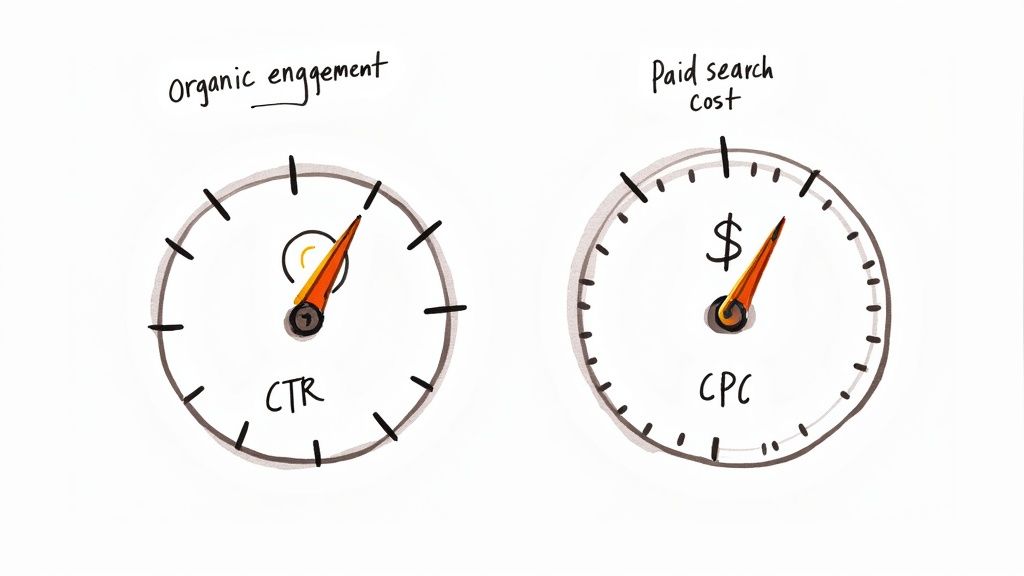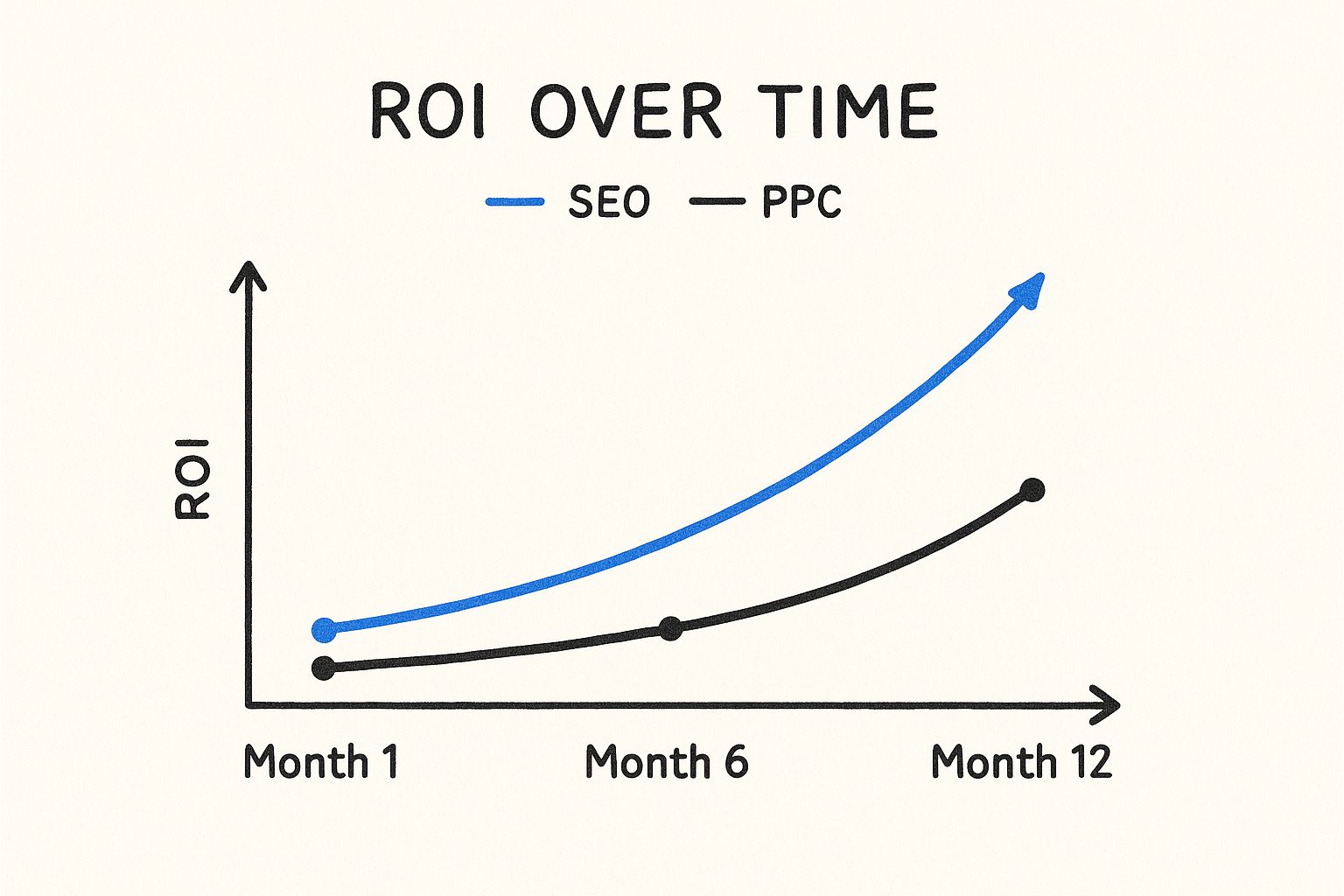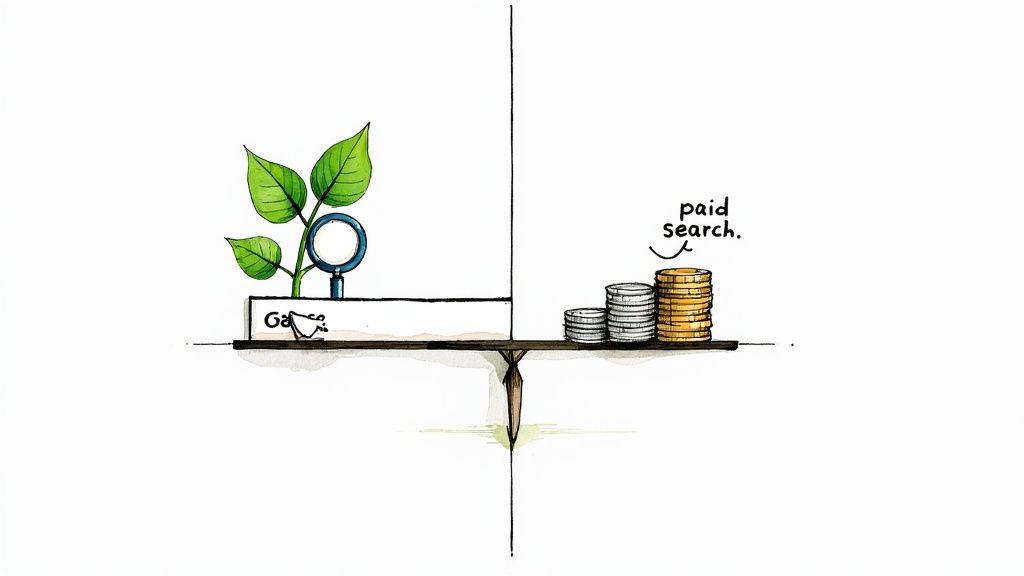When you boil it down, the difference between natural search vs paid search is straightforward, especially within the Google ecosystem. Natural search, or SEO, is about earning your spot in Google's results for free by being the most relevant and authoritative answer. It’s a long game. Paid search, primarily through Google Ads, is about buying your way to the top for immediate visibility. One is an investment in a long-term asset; the other is like renting a billboard on the world's busiest digital highway.
Defining the Core Difference in Search
To really get a handle on the differences, you have to understand the bigger picture of how businesses get found online. Both SEO and PPC fall under the umbrella of search engine marketing, but they work in completely different ways. If you're new to this, a comprehensive guide to Search Engine Marketing can give you some great foundational knowledge.
What Is Natural Search?
Natural search, better known as Search Engine Optimization (SEO), is the craft of getting your website to show up higher in the unpaid search results. It’s a marathon, not a sprint. This means you're creating genuinely helpful content, making sure your site is technically sound, and building a solid online reputation. In short, you're earning Google's trust, and Google rewards that trust with visibility.
What Is Paid Search?
Paid search, which you'll almost always hear called Pay-Per-Click (PPC), is exactly what it sounds like. You bid to place your ads at the very top of the search results. Using a platform like Google Ads, you pay every single time someone clicks your ad. This approach gives you instant, highly controlled traffic from day one, with tools like Performance Max and Smart Bidding using AI to optimize your campaigns.
Natural vs Paid Search At a Glance
So, which one is right for you? That really depends on your goals, your budget, and how quickly you need to see results. There's no single right answer, just the right answer for your specific situation.
Here’s a quick breakdown of how the two stack up against each other.
| Attribute | Natural Search (SEO) | Paid Search (PPC via Google Ads) |
|---|---|---|
| Cost Model | No direct cost for placement; investment in resources (content, technical SEO) | Pay-per-click (PPC); direct cost for every ad click, managed via budget caps |
| Speed to Results | Slow; typically takes months to see significant results | Fast; can generate traffic and leads almost instantly after campaign setup |
| Sustainability | High; traffic continues even after investment stops, creating a lasting asset | Low; traffic stops immediately when you stop paying |
| User Trust | High; users often trust organic results more than paid ads | Moderate; users recognize these as advertisements, though trust has grown |
Looking at these side-by-side, you can see the trade-offs. You either invest time to build a sustainable asset with SEO or spend money to get immediate, but temporary, traffic with Google Ads.
It's also worth noting where users tend to click. Organic search is a powerhouse, driving about 53.3% of all website traffic. People inherently trust it more. However, Google's continuous updates, like adding more ad placements and features like AI Overviews, are shifting user behavior, making paid ads more prominent and effective than ever.
Comparing Performance Metrics and User Intent

The real difference between natural search and paid search snaps into focus when you look at how success is measured. Each channel catches people in different frames of mind, which completely changes the key performance indicators (KPIs) you should be watching. One is all about earning authority and trust, while the other is a straightforward measure of campaign profitability within the Google Ads platform.
Getting this right is crucial for deciding where to put your money and effort. You wouldn't judge a marathon runner on their 100-meter dash time, and the same logic applies here.
Gauging Success in Natural Search
With organic search, you're playing the long game. Success is built piece by piece, by earning the trust of both users and search engines. The metrics you track reflect this deep focus on authority, relevance, and genuine engagement. You're not just trying to get a click; you're building a lasting relationship with your audience.
The key performance metrics for SEO are all about this sustained growth:
- Organic Rankings: Where you show up in the search results for your keywords is the most basic sign of your visibility and authority.
- Organic Click-Through Rate (CTR): This tells you how well your title and meta description are working. It's the percentage of people who see your listing and are compelled enough to actually click it.
- On-Page Engagement: Metrics like time on page and bounce rate show whether your content delivered on its promise once someone landed on your site.
These numbers tell a story about the quality of your content and the overall health of your website. A high ranking paired with strong engagement sends a powerful signal to Google that you're a credible source, which helps lock in your position over time.
A strong organic presence isn't just about traffic; it's a powerful signal of brand authority. When users see your site consistently ranking for their queries, it builds a level of trust that paid ads often cannot replicate on their own.
Measuring Profitability in Paid Search
In the world of Google Ads, performance is all about efficiency and a direct return on your investment. The metrics are much more transactional, largely because the user is often much closer to making a purchase. You're essentially paying for a shortcut to people who are actively looking to buy something or solve a problem right now.
For Google Ads, success lives and dies by the financial metrics:
- Cost-Per-Click (CPC): This is the exact price you pay for every single click on your ad. It’s a fundamental measure of how competitive the ad auction is.
- Conversion Rate: This is the percentage of people who clicked your ad and then took the action you wanted, like filling out a form or buying a product.
- Return on Ad Spend (ROAS): This is the bottom line. It calculates the total revenue you generated for every dollar you spent on your ads, showing you what’s truly profitable.
By keeping a close eye on these numbers, advertisers can tell almost immediately if a campaign is working and make smart, data-backed decisions to improve it. For a deeper look, you can learn more about the crucial digital advertising performance metrics that spell success for paid campaigns. When it comes down to it, the natural search vs paid search debate is really about how you define—and measure—a win for your business.
Analyzing the True Cost and ROI Potential
When people compare natural search and paid search, one of the biggest misconceptions is calling SEO "free." While you don't pay Google directly for a top organic spot, getting there requires a serious investment of time, talent, and resources.
The real difference isn't about cost versus no cost; it's about how you invest and what kind of return you can expect from that investment.
The Long-Term Value of SEO Investment
With paid search on a platform like Google Ads, the costs are straightforward. You have your ad spend (what you pay for clicks) and sometimes campaign management fees if you hire an expert or an agency. These are predictable expenses tied directly to the traffic you generate.
On the other hand, the costs for natural search are all about building a valuable digital asset. You're investing in things like:
- Content Creation: Crafting in-depth articles, helpful guides, and engaging videos that actually deserve to rank.
- Technical Optimization: Making sure your website is fast, secure, and easy for search engines to understand.
- Authority Building: Earning backlinks from other credible websites, which is like getting a vote of confidence for your domain.
The payback here isn't immediate. But unlike paid ads, it snowballs. Every piece of content you create and every link you earn builds on the last, strengthening your site's authority. This creates a powerful, sustainable source of traffic that keeps delivering results long after you've done the initial work.
This infographic paints a clear picture of how the ROI for each channel typically plays out over 12 months.

You can see paid search gets you results right out of the gate. But SEO, while a slow burn at first, eventually crosses a tipping point where it delivers a much higher and more durable return on investment.
The Immediate Impact of Paid Search
Paid search, powered by Google Ads, delivers a direct, almost instant return. The second your campaign goes live, you can start driving highly targeted visitors to your site. This is exactly why it's so critical for businesses that need to see results now.
The core difference in ROI is durability. SEO builds an asset that pays dividends indefinitely, much like owning a home. Paid search provides immediate value but stops the second you stop paying—it's like renting.
Google Ads is the perfect partner to SEO, delivering quick traffic and precise targeting. Research shows that paid search can boost website traffic by up to 53%, making it a fantastic tool for getting seen quickly. What's more, about 75% of users say paid ads make it easier to find what they're looking for, which shows just how effective well-targeted campaigns can be. You can discover more insights about organic vs paid search on seoprofy.com.
Ultimately, the right choice comes down to your business goals and timeline. SEO is the long game for building compounding value, while Google Ads is your go-to for immediate, predictable, and scalable results.
Choosing the Right Channel for Your Business Goal

Knowing the difference between natural and paid search is the first step. The real strategy comes from knowing when to use each one. It's never about which is better overall, but which one is the right tool for the job you need to get done right now. Your goals, your timeline, and where you stand in the market should drive your decision.
Think of it this way: if you need to hit the ground running today, paid search with Google Ads is your rocket ship. It’s built for speed, putting you in front of the right people the moment you hit "launch." On the other hand, natural search is like building a solid foundation. It's all about steady, long-term growth and earning your spot at the top.
When to Go Full Throttle with Paid Search
Google Ads is the answer when you need immediate results and total control. It's the perfect move when you have to make a big splash, try out a new concept, or connect with customers who are actively looking to buy right now.
You should lean on Google Ads for goals like these:
- Launching a New Product or Service: You can instantly get eyes on your new offering, skipping the months it might take to show up in organic search.
- Running Time-Sensitive Promotions: A Black Friday deal or a limited-time offer can’t wait. Paid ads deliver the immediate visibility you need.
- Generating High-Quality Leads, Fast: If your sales team is hungry for leads today, a well-optimized lead generation campaign in Google Ads is the most direct way to fill their pipeline.
- Testing Market Messaging: Before you pour resources into a long-term SEO plan, you can use Google Ads to quickly find out which headlines and value propositions actually get clicks.
Paid search gives you invaluable speed and data. It’s a real-time laboratory for understanding customer behavior and validating your marketing messages before you invest heavily in long-term organic content.
When to Invest in Long-Term Natural Search
Natural search is the marathon, not the sprint. It’s how you build a marketing machine that runs on its own, generating traffic and authority for years. This is the right path when your goals are centered around trust, credibility, and growth that builds on itself over time.
Focus on SEO when your objectives include:
- Building Brand Credibility and Trust: Ranking organically for important industry terms shows you're a legitimate authority. That's a level of trust paid ads just can't buy.
- Establishing Industry Authority: When you consistently create helpful, in-depth content that solves problems, you become the go-to resource in your space.
- Creating a Cost-Effective Traffic Engine: SEO definitely requires an investment upfront, but it eventually brings in "free" traffic, which drives down your cost to acquire a customer over the long haul.
- Targeting the Entire Customer Journey: SEO lets you connect with people at every stage, from when they first realize they have a problem to when they're comparing their final options.
Deciding between natural search vs paid search really comes down to what you're trying to accomplish. To make this even clearer, let's look at some common business goals and which channel makes the most sense.
Strategic Use Cases for Natural vs Paid Search
| Business Goal | Recommended Channel | Rationale |
|---|---|---|
| Validate a new business idea | Paid Search (Google Ads) | Get immediate traffic and conversion data to see if there's real market demand before investing in long-term assets. |
| Become the go-to expert in your niche | Natural Search | Consistently publishing high-quality, authoritative content builds long-term trust and organic rankings that position you as a leader. |
| Drive sign-ups for a webinar next week | Paid Search (Google Ads) | The tight deadline requires the immediate visibility and precise targeting that only paid ads can guarantee. |
| Reduce customer acquisition costs over time | Natural Search | Once you achieve strong rankings, the ongoing traffic is essentially free, creating a sustainable and cost-effective marketing channel. |
| Dominate a competitor's brand keywords | Paid Search (Google Ads) | You can directly target competitor brand names to capture their audience and present your alternative, a tactic not possible with SEO. |
| Support a new product launch | Both | Use Google Ads for an immediate traffic surge at launch, while simultaneously building out an organic content strategy to support it long-term. |
Ultimately, paid search is your tool for immediate impact and tactical moves, while natural search is for building a digital asset that will pay dividends for years to come.
Integrating SEO and PPC for Maximum Growth
The whole "natural search vs paid search" debate? It's the wrong way to look at it. The smartest marketers don't pick a side; they make the two work together within the Google Ads ecosystem. When you get your SEO and PPC strategies in sync, you create a feedback loop that lets you completely dominate the search results page.
This isn't about running two separate campaigns. It's about turning Google Ads data into organic content wins while using your strong organic presence to make your ads cheaper and more effective. You cover all your bases and build momentum that neither channel could achieve alone.
Fueling SEO with Paid Search Data
One of the best ways to get started is by using your Google Ads data to sharpen your SEO strategy. Your paid campaigns are a live experiment, giving you a constant stream of real-world data on which keywords drive not just traffic, but actual conversions.
Look at your best-performing ad groups. Inside, you'll find your "money" keywords—the ones with a proven track record of bringing in leads or sales. You can then build your content strategy around these terms, confident that you’re targeting topics that directly impact your bottom line. It completely removes the guesswork.
Your Google Ads account is a live testing ground for your SEO. Use it to find high-intent keywords, test headlines via ad copy, and discover what messaging truly resonates with your audience before you invest months into an organic campaign.
This data-driven approach is more critical than ever. The search results page is constantly changing, with AI-driven features like Google's AI Overviews providing direct answers and leading to more zero-click searches. This means you have to be smarter, using insights from your paid campaigns to create organic content that truly engages users. If you're interested in the data, you can learn more about evolving CTR trends on rankfuse.com.
A Multi-Pronged Integration Strategy
Going beyond just keywords, a truly integrated strategy uses each channel to reinforce the other in a continuous cycle. The goal is total SERP dominance and a much better experience for the searcher.
Here are a few powerful Google Ads tips to combine your efforts:
- Retarget Organic Visitors: Set up paid ad campaigns that only target people who previously found your site through organic search. This is a great way to stay top-of-mind and bring back warm traffic that didn't convert the first time around.
- Defend Branded Keywords: Don't assume you'll always rank #1 for your own name. Competitors can, and will, bid on your brand in Google Ads. Running your own paid campaign on your brand name lets you control the message and capture that high-intent traffic, boxing out anyone trying to ride your coattails.
- Boost Your Quality Score: When you have a strong organic presence, Google sees you as a relevant authority in your space. This often translates to a higher Quality Score for your ads, which can lead to lower costs per click and better ad positions. It's a direct financial benefit of good SEO.
So, Which One Is Right for Your Business?
People often talk about natural search vs paid search as if you have to pick one and stick with it. But the smartest Google Ads strategies don't choose a side. Instead, they blend the two to match immediate goals with long-term vision.
Your decision really comes down to an honest look at where your business is right now. A few straightforward questions can cut through the noise and help you figure out where to put your money and effort to build a search presence that actually works.
A Quick Reality Check for Your Strategy
Look at your business through these three lenses. They’ll help you decide whether to lean into the instant results of paid ads or the long-term staying power of organic search.
-
What’s your budget really like? Do you have enough cash on hand to keep a Google Ads campaign running consistently? If things are tight, pouring your energy into the "sweat equity" of SEO might make more sense, even if it takes a while to see results.
-
How old is your business? If you're just starting out, you need to validate your idea and get customer feedback fast. Paid search is perfect for that. But if you’re an established brand looking to build a legacy and lower your acquisition costs over time, natural search is the foundation you need.
-
Who are you up against? Is your market packed with competitors throwing big money at the top keywords? Trying to win with paid ads alone could drain your bank account. A solid SEO plan can help you find a unique angle and build up authority that your rivals simply can't purchase.
A winning search strategy isn’t about making one choice and never looking back. It’s about smartly shifting your resources. Start where your need is greatest—whether that's speed or sustainability—and let the strengths of one channel fill the gaps of the other.
Ultimately, whether you focus on natural search, paid search, or both comes down to your specific situation. Even your location can play a huge role, a point that often comes up in local discussions like SEO vs Paid Ads for Brisbane businesses. By asking the right questions, you can stop debating and start building a strategy that delivers.
Common Questions About Natural and Paid Search
As you dive into search marketing and Google Ads, you’ll quickly run into the same questions that everyone else does. The whole natural search vs. paid search debate can feel a bit overwhelming, so let's break down the most common sticking points with some clear, no-nonsense answers.
Getting these fundamentals right will help you avoid some classic blunders and build a much smarter search strategy from day one.
Which Is Better for a New Business: Natural Search or Paid Search?
For a business that’s just starting out, paid search is almost always the best place to begin. It’s all about getting immediate results. With Google Ads, you can switch on the traffic and instantly start collecting real-world data about your market.
This is your chance to quickly find out if your product, pricing, and sales pitch actually work with real customers. While you should absolutely be laying the groundwork for your SEO from the get-go, earning trust and climbing the rankings takes time. The smart play is to use Google Ads to get leads in the door while your long-term natural search strategy builds up steam in the background.
Can I Stop Paid Ads Once My SEO Is Strong?
You could, but it’s rarely a good idea if you want to keep growing. Even when you've got top-notch organic rankings, Google Ads does things that SEO simply can't.
Think of it this way: even if you own the best store on the block (SEO), you still want a billboard out front (PPC). One builds your reputation, the other grabs immediate attention.
Here’s why you'll want to keep both channels active:
- Owning the Page: When you have both the top paid and organic spots, you physically push your competitors further down the search results. It’s a powerful way to maximize your real estate.
- Playing Defense: Your competitors can—and often will—bid on your brand name in Google Ads. Running your own paid ads on your brand terms is a cheap way to protect that traffic and ensure you control the message.
- Fast Testing: Paid search lets you test new offers, landing pages, and ad copy on the fly. You can take what you learn from those quick experiments and feed it right back into your SEO strategy.
How Do I Measure the ROI of Natural Search?
Measuring the return on your SEO investment isn't as clean as checking your ROAS in a Google Ads dashboard, but it's definitely doable. The key is to track a few core metrics over time to see the combined impact of your work.
To really understand the return, you need to focus on these three things:
- Organic Traffic Growth: Keep an eye on the number of visitors coming from non-paid search in your Google Analytics account. Is it trending up?
- Keyword Ranking Improvements: Track where you rank for the keywords that matter. Moving up into the top 10 results directly translates to more qualified traffic.
- Organic Conversions: You must set up conversion goals in Google Analytics. This lets you see exactly how many leads, form submissions, or sales are coming directly from your organic traffic.
The results won't be instant, but a steady climb in these numbers is the clearest sign you’ll get that your natural search efforts are paying off.
Stop manually downloading leads from Google Ads. Pushmylead instantly forwards every new lead from your Google lead form extensions directly to your inbox, so you can follow up in minutes, not hours. See how it works at https://www.pushmylead.com.
